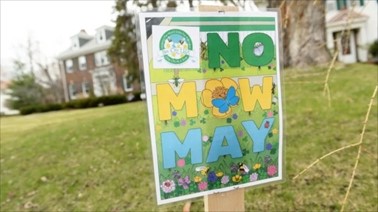No Mow May: A way of doing more for pollinators by doing less this spring
By MOLLY GUTHREY | mguthrey@pioneerpress.com | Pioneer Press

A No Mow May sign in the St. Paul yard of Gretchen Cudak of St. Paul on Thursday, April 28, 2022. By not mowing in May and letting dandelions, clover, creeping Charlie and other flowers bloom, people are creating habitat for pollinators, including bees, and other wildlife. (Scott Takushi / Pioneer Press)
On a chilly morning in late April, Amanda Lynch planted a city-issued sign in her family’s front yard.
“No Mow May,” it proclaimed.
It was her dad’s idea to take part in this environmental initiative in West St. Paul, but the city and her father have her full support.
“I like it because I don’t have to mow the yard,” said Lynch, 20, with a laugh. “It’s a good idea, though — to give the lawn the opportunity to start growing and get everything started.”
POLLINATOR PERKS
No Mow May’s purpose is actually for pollinators, and it’s a blossoming trend across the U.S. — including city-led initiatives in West St. Paul, Edina and New Brighton.
What’s the purpose of doing less — to let the grass grow shaggy; to let the dandelions grow; to hold off on that spring cleanup of leaves?
“No Mow May is a campaign to raise awareness of the importance of spring flowers for bees,” said Elaine Evans, extension educator at the University of Minnesota. “In May, many bees are coming out of hibernation and need flowers to feed themselves and their babies. The main purpose of No Mow May is to encourage people to let spring flowers in their lawns bloom before mowing.”
The bees needing an assist include the endangered rusty patched bumblebee, which became Minnesota’s state bee in 2019.
“The rusty patched bumblebee used to be common in Minnesota but is now very rare,” Evans says. “It is threatened with extinction, but still can be found in many parts of Minnesota, with many recent sightings in the Twin Cities. By creating a pollinator haven in your yard, you can help the rusty patched bumble bee recover.”
Planting pollinator-friendly flowers is an idea people are familiar with, but it’s probably going to take a lot of signs to spread the message to Americans that they should consider letting their yards grow more wild — to let the creeping Charlie creep, to let the clover flourish.
“It’s all about education,” says Gretchen Cudak, a member of the St Paul Garden Club. “We all need to refocus and regroup about what we think is normal and good — because what we think is normal and good is not normal and good for pollinators. The bees are really suffering.”
A BRITISH IMPORT
The idea for No Mow May took root across the pond: The annual campaign by Plantlife, a conservation group in England, inspired the city of Appleton, Wis., to pass a resolution to do the same, as well as Lawrence University of Appleton. Both the city and the university are affiliates of the Xerces Society, an Oregon-based environmental organization (named after an extinct butterfly) that organizes programs called Bee City USA and Bee Campus USA.
No Mow May has slowly been spreading, like honey on toast.
“It just went viral this year,” says Laura Rost, coordinator for Bee City USA and Bee Campus USA.
It’s not just about lawns and it’s not just about May, though.
“We think of No Mow May as one thing you can do; a starting point to helping bees,” Rost says. “The month of May might not be the best month for all areas of the country. But studies show it’s a very important part of the year for many bees. If you mow less or not at all when they are emerging, you tend to see a higher number of species of bees and a higher abundance of bees overall, if there are flowers are in the grass.”
Flowers … in the grass?
Elaine Evans, extension educator at the University of Minnesota, recommends four actions that anyone can take to help pollinators:
- Plant flowers: Whether it is a pot, a patch, or a prairie, every bit helps. Keep those flowers free of pesticides and look for plants that are native to your area. (Consider adding violets and pussy toes. For blooms after May, add self-heal, ground plum, lanceleaf tickweed or calico American aster. If you want to do even more for pollinators in May, plant native spring blooming flowers, trees, and shrubs, like pussy willows, serviceberries, and bluebells.)
- Create homes: You can create safe spaces for pollinators by leaving some messy corners in your yard with leaves, logs, and standing stems. A diversity of native plants can be homes for caterpillars.
- Take climate action: Plant trees and native grasses with deep roots. Switch to clean energy sources. Support sustainable farming. Our future food supply depends on pollinators and they depend on a stable climate.
- Collect data: By taking photos of pollinators and sharing them on the app iNaturalist, you can help scientists track and protect them.
Get more local info and resources at the University of Minnesota’s Bee Lab at Beelab.umn.edu and the Minnesota Bumble Bee Atlas.
To read the whole article go to: https://www.twincities.com/2022/04/30/no-mow-may-pollinators-grass-flowers-bees/








